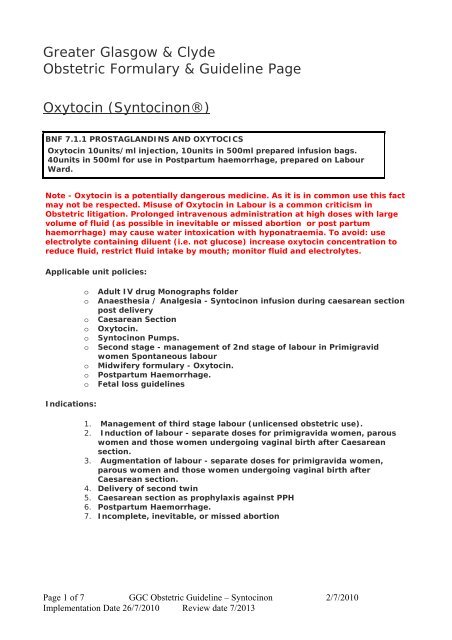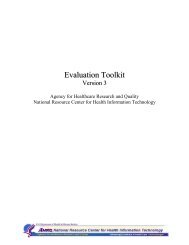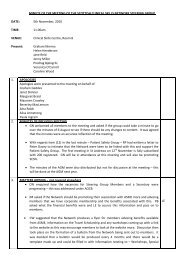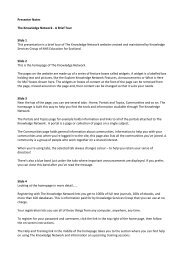Syntocinon guideline GGC.pdf
Syntocinon guideline GGC.pdf
Syntocinon guideline GGC.pdf
You also want an ePaper? Increase the reach of your titles
YUMPU automatically turns print PDFs into web optimized ePapers that Google loves.
Greater Glasgow & Clyde<br />
Obstetric Formulary & Guideline Page<br />
Oxytocin (<strong>Syntocinon</strong>®)<br />
BNF 7.1.1 PROSTAGLANDINS AND OXYTOCICS<br />
Oxytocin 10units/ml injection, 10units in 500ml prepared infusion bags.<br />
40units in 500ml for use in Postpartum haemorrhage, prepared on Labour<br />
Ward.<br />
Note - Oxytocin is a potentially dangerous medicine. As it is in common use this fact<br />
may not be respected. Misuse of Oxytocin in Labour is a common criticism in<br />
Obstetric litigation. Prolonged intravenous administration at high doses with large<br />
volume of fluid (as possible in inevitable or missed abortion or post partum<br />
haemorrhage) may cause water intoxication with hyponatraemia. To avoid: use<br />
electrolyte containing diluent (i.e. not glucose) increase oxytocin concentration to<br />
reduce fluid, restrict fluid intake by mouth; monitor fluid and electrolytes.<br />
Applicable unit policies:<br />
o<br />
o<br />
o<br />
o<br />
o<br />
o<br />
o<br />
o<br />
o<br />
Adult IV drug Monographs folder<br />
Anaesthesia / Analgesia - <strong>Syntocinon</strong> infusion during caesarean section<br />
post delivery<br />
Caesarean Section<br />
Oxytocin.<br />
<strong>Syntocinon</strong> Pumps.<br />
Second stage - management of 2nd stage of labour in Primigravid<br />
women Spontaneous labour<br />
Midwifery formulary - Oxytocin.<br />
Postpartum Haemorrhage.<br />
Fetal loss <strong>guideline</strong>s<br />
Indications:<br />
1. Management of third stage labour (unlicensed obstetric use).<br />
2. Induction of labour - separate doses for primigravida women, parous<br />
women and those women undergoing vaginal birth after Caesarean<br />
section.<br />
3. Augmentation of labour - separate doses for primigravida women,<br />
parous women and those women undergoing vaginal birth after<br />
Caesarean section.<br />
4. Delivery of second twin<br />
5. Caesarean section as prophylaxis against PPH<br />
6. Postpartum Haemorrhage.<br />
7. Incomplete, inevitable, or missed abortion<br />
Page 1 of 7 <strong>GGC</strong> Obstetric Guideline – <strong>Syntocinon</strong> 2/7/2010<br />
Implementation Date 26/7/2010 Review date 7/2013
Table 1. Oxytocin infusion 10 units in 500ml<br />
Time after starting<br />
(minutes)<br />
Oxytocin dose<br />
(milliunits per minute)<br />
Volume infused<br />
(ml/hour) of dilution<br />
Oxytocin 10 units in<br />
500ml<br />
0 1 3<br />
30 2 6<br />
60 4 12<br />
90 8 24<br />
120 12 36<br />
150 16 48<br />
180 20 60<br />
210 * 24 72<br />
240 * 28 84<br />
270 * 32 96<br />
Doses highlighted with (*) are quantities above those referred to in the summary of product<br />
characteristics of 20 milliunits per minute.<br />
Indication: 1. Management of third stage labour.<br />
Drug Dose No. of doses Route<br />
Oxytocin<br />
10units/ml inj.<br />
10units<br />
(1ml)<br />
One dose only, give with or after delivery of<br />
the shoulders.<br />
I.M.<br />
Page 2 of 7 <strong>GGC</strong> Obstetric Guideline – <strong>Syntocinon</strong> 2/7/2010<br />
Implementation Date 26/7/2010 Review date 7/2013
Indication: 2. Induction of labour.<br />
Induction of labour should be for a clearly documented reason. Such patients must<br />
have had a spontaneous rupture of membranes or have had a forewater amniotomy<br />
performed prior to commencement of oxytocin.<br />
Primigravida Women - See BNF for restrictions on use.<br />
Drug<br />
Oxytocin<br />
infusion 10<br />
units in 500ml<br />
Compound<br />
Sodium<br />
Lactate<br />
Initial infusion rate set<br />
at<br />
It may be gradually<br />
increased at intervals no<br />
shorter than 30<br />
minutes, until a<br />
contraction pattern<br />
similar to that of normal<br />
labour is established.<br />
Aim for 3 good<br />
contractions in 10<br />
minutes.<br />
Dose Primigravida<br />
Women<br />
No. of<br />
doses<br />
Route<br />
1mU/minute (3ml/hour) Continuous I.V. Inf.<br />
In practice this is<br />
achieved by doubling the<br />
dose at intervals of no<br />
less than 30 minutes to<br />
a maximum of<br />
20mU/minute<br />
(60ml/hour).<br />
Further increase (see<br />
chart above) should be<br />
after discussion with<br />
Middle grade<br />
obstetrician.<br />
Continuous I.V. Inf.<br />
Page 3 of 7 <strong>GGC</strong> Obstetric Guideline – <strong>Syntocinon</strong> 2/7/2010<br />
Implementation Date 26/7/2010 Review date 7/2013
Indication: 2. Induction of labour – continued.<br />
Induction of labour should be for a clearly documented reason. Such patients must<br />
have had a spontaneous rupture of membranes or have had a forewater amniotomy<br />
performed prior to commencement of oxytocin.<br />
Parous women- See BNF for restrictions on use.<br />
These women have a significant risk of uterine rupture, whether or not they have had a<br />
previous caesarean section, and whether or not they are in spontaneous or induced labour.<br />
The maximum dose should be at a rate of 16mU/minute (48ml/hour). Dose increases<br />
above this must be documented in case notes by senior obstetric staff (Middle<br />
Grade rota or above).<br />
OXYTOCIN IS ADMINISTERED TO ACHIEVE 3 GOOD CONTRACTIONS IN 10 MINUTES. THE<br />
DOSE CAN OFTEN BE REDUCED TO MAINTAIN THIS. ONCE IN ESTABLISHED LABOUR A<br />
PAROUS WOMAN IS UNLIKELY TO NEED ESCALATING DOSES OF OXYTOCIN. It is uncommon<br />
for a Parous women in spontaneous labour to require augmentation with oxytocin. Poor<br />
progress in both the first and second stage of labour indicates the need to exclude the<br />
following: malposition, malpresentation, Cephalopelvic, disproportion. Such patients require<br />
assessment by a middle grade obstetrician prior to discussion with a consultant.<br />
Drug<br />
Oxytocin<br />
infusion 10<br />
units in 500ml<br />
Compound<br />
Sodium Lactate<br />
Dose Parous<br />
patients<br />
No. of<br />
doses<br />
Route<br />
Initial infusion rate set at 1mU/minute (3ml/hour) Continuous I.V. Inf.<br />
It may be gradually<br />
increased at intervals no<br />
shorter than 30 minutes,<br />
until a contraction pattern<br />
similar to that of normal<br />
labour is established. Aim<br />
for 3 good contractions in 10<br />
minutes.<br />
In practice this is<br />
achieved by doubling the<br />
dose at intervals of no<br />
less than 30 minutes to a<br />
maximum of<br />
16mU/minute<br />
(48ml/hour).<br />
Continuous<br />
I.V. Inf.<br />
Page 4 of 7 <strong>GGC</strong> Obstetric Guideline – <strong>Syntocinon</strong> 2/7/2010<br />
Implementation Date 26/7/2010 Review date 7/2013
Indication: 3. Augmentation of labour.<br />
This refers to women diagnosed as being established in labour but who have slow<br />
progress which is suspected to be due to inefficient (in-coordinate) uterine<br />
contractions. Membrane rupture must have occurred, whether spontaneous or<br />
artificially. Augmentation is different from induction. Evidence of a positive effect<br />
should be apparent in the next assessment.<br />
Primigravida Women - See BNF for restrictions on use.<br />
Drug<br />
Oxytocin<br />
infusion 10<br />
units in 500ml<br />
Compound<br />
Sodium<br />
Lactate<br />
Dose Primigravida Women<br />
No. of<br />
doses<br />
Route<br />
Initial infusion rate set at 1mU/minute (3ml/hour) Continuous I.V. Inf.<br />
It may be gradually<br />
increased at intervals no<br />
shorter than 30 minutes,<br />
until a contraction pattern<br />
similar to that of normal<br />
labour is established. Aim<br />
for 3 good contractions in<br />
10 minutes.<br />
In practice this is achieved by<br />
doubling the dose at intervals of<br />
no less than 30 minutes to a<br />
maximum of 20mU/minute<br />
(60ml/hour). If commenced for<br />
first time in 2nd stage of labour,<br />
intervals of no less than 20<br />
minutes may be used.<br />
Continuous I.V. Inf.<br />
Parous women- See BNF for restrictions on use.<br />
*Prior to commencing oxytocin for augmentation of labour in parous women an<br />
obstetrician (Middle Grade rota or above) should perform a clinical assessment<br />
including a vaginal examination to exclude any evidence of obstructed labour,<br />
malposition, and /or malpresentation or CPD. A clinical assessment including a<br />
repeat V/E should be performed after 2 hours of oxytocin to ensure effective<br />
progress.<br />
These women have a significant risk of uterine rupture. Particularly high risk groups are<br />
women with previous caesarean section or high parity (para >4), the maximum dose should<br />
be at a rate of 16mU/minute (48ml/hour). Dose increases above this must be<br />
documented in case notes by senior obstetric staff (Middle Grade rota or above).<br />
Drug<br />
Oxytocin<br />
infusion 10<br />
units in 500ml<br />
Compound<br />
Sodium Lactate<br />
Dose Parous patients<br />
Initial infusion rate set at 1mU/minute (3ml/hour)<br />
It may be gradually<br />
increased at intervals no<br />
shorter than 30 minutes,<br />
until a contraction<br />
pattern similar to that of<br />
normal labour is<br />
established. Aim for 3<br />
good contractions in 10<br />
minutes.<br />
In practice this is achieved by<br />
doubling the dose at intervals<br />
of no less than 30 minutes to a<br />
maximum of 16mU/minute<br />
(48ml/hour). Only a<br />
consultant can commence<br />
oxytocin for first time in 2nd<br />
stage of labour.<br />
No. of<br />
doses<br />
Route<br />
Continuous I.V. Inf.<br />
Continuous I.V. Inf.<br />
Page 5 of 7 <strong>GGC</strong> Obstetric Guideline – <strong>Syntocinon</strong> 2/7/2010<br />
Implementation Date 26/7/2010 Review date 7/2013
Indication: 4. Delivery of second twin in those women who do not have an<br />
oxytocin infusion running and after confirming a longitudinal lie and a normal CTG.<br />
Drug<br />
Oxytocin<br />
infusion 10<br />
units in 500ml<br />
Compound<br />
Sodium Lactate<br />
Dose<br />
No. of<br />
doses<br />
Route<br />
Initial infusion rate set at 2mU/minute (6ml/hour) Continuous I.V. Inf.<br />
It may be gradually<br />
increased at intervals no<br />
shorter than 20 minutes,<br />
until a contraction pattern<br />
similar to that of normal<br />
labour is established. Aim<br />
for 3 good contractions in 10<br />
minutes.<br />
In practice this is<br />
achieved by doubling the<br />
dose at intervals of no<br />
less than 20 minutes to a<br />
maximum of<br />
16mU/minute<br />
(48ml/hour).<br />
Continuous<br />
I.V. Inf.<br />
Indication: 5. Post Caesarean Section prophylaxis<br />
Elective and emergency Caesarean Section are associated with increase risk of PPH. Uterine<br />
atony after long labour. Multiple pregnancy and high parity are particular risks<br />
Drug<br />
Dose<br />
No. of<br />
doses<br />
Route<br />
Oxytocin injection<br />
5 units after delivery of the baby<br />
then see below<br />
once only<br />
IV BOLUS<br />
slowly<br />
Oxytocin infusion equivalent to<br />
15 units in a fresh bag of 500ml<br />
Compound Sodium Lactate.<br />
Aim for infusion to be completed<br />
by 30 minutes.<br />
Continuous<br />
I.V. Inf.<br />
Notes<br />
*Oxytocin Maximum dose should rarely exceed 50 units total.<br />
Page 6 of 7 <strong>GGC</strong> Obstetric Guideline – <strong>Syntocinon</strong> 2/7/2010<br />
Implementation Date 26/7/2010 Review date 7/2013
Indication: 6. Postpartum Haemorrhage.<br />
Drug<br />
Oxytocin infusion 40 units in 500ml<br />
Compound Sodium Lactate.*<br />
Dose<br />
No. of<br />
doses<br />
Route<br />
125ml/ hour. Continuous I.V. Inf.<br />
* In fluid restricted patients Oxytocin 40 units in 40ml Sodium Chloride 0.9% infused IV<br />
at 10ml /hr may be considered.<br />
Indication: 7. Incomplete, inevitable or missed abortion – when prostaglandins<br />
have not been successful or are contraindicated.<br />
Drug<br />
Oxytocin injection<br />
Oxytocin infusion 10 units in<br />
500ml Compound Sodium<br />
Lactate.<br />
Dose<br />
5 units then see below if<br />
necessary<br />
Initially 20 to 40<br />
milliunits/minute (60ml/hr to<br />
120ml/hr) or higher<br />
No. of<br />
doses<br />
Once only<br />
Route<br />
IV BOLUS<br />
slowly<br />
Continuous I.V. Inf.<br />
Authors<br />
Updated by Dr A M Mathers, Dr F Mackenzie, J Grant, Pharmacist, Check A M Smith,<br />
Pharmacist, on behalf of GONEC Group<br />
Title<br />
Oxytocin Guideline_Obstetrics Version 1<br />
Implementation / review Dates<br />
Implementation 26/7/10 Review date 7/13<br />
Approval<br />
A.M. Mathers, Clinical Director..................................... Date .......................<br />
Page 7 of 7 <strong>GGC</strong> Obstetric Guideline – <strong>Syntocinon</strong> 2/7/2010<br />
Implementation Date 26/7/2010 Review date 7/2013
















